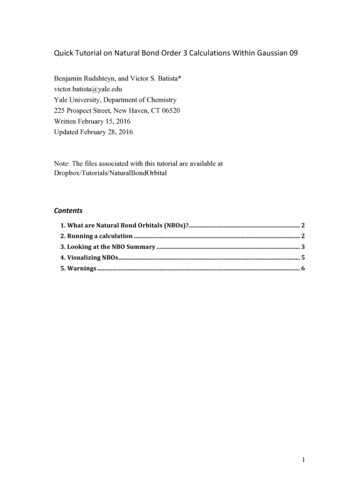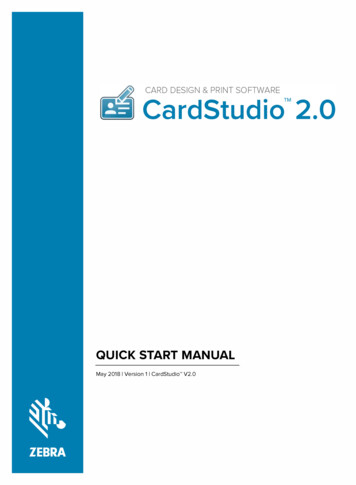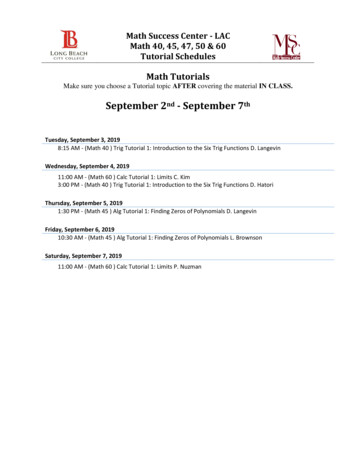
Transcription
Gaussian09Benjamin Rudshteyn, and Victor S. Batista*victor.batista@yale.eduYale University, Department of Chemistry225 Prospect Street, New Haven, CT 06520Written February 15, 2016Updated February 28, 2016Note: The files associated with this tutorial are available 55.Warnings.61
1.WhatareNaturalBondOrbitals(NBOs)?The nboguide.pdf document in the Dropbox (or /qc/docs/nboguide.pdf) explainsNBOs more. It is good to look at the first 5 pages at least. Essentially they are adifferent way of reporting the molecular orbitals. They are more localized, like invalence bond theory, and are thus more chemically intuitive.2.RunningacalculationWe will be looking at the following example molecule, propiolamide, saved inallBonds.gjf, because it has single (1-3), double (1-2), and triple bonds (6-7). Keep inmind that it is not relaxed, which is why the presumed 1.5 bond order of C(1)-N(3) isnot reflected in this calculation.allBonds.gjfCreated by GaussView 5.0.902/15/16 15:15:5128O761NH 23propiolamide45Figure 1. Chemical structure and numbering scheme for propiolamide, the examplemolecule.The important part of the input file is the pop (nbo,savenbo) keyword.Running this calculation produces the following section with more stars and withoutcarriage returns.******************************Gaussian NBO Version sian NBO Version 3.1 **************2
3.LookingattheNBOSummaryIt looks like the most relevant section is Natural Bond Orbitals (Summary):, whichfor the example molecule is as follows (at least part of it):3
The columns give you the NBO (specifically, the number of the orbital, the number ofappearance, the element symbol, its own label, the atom it is bonded to (if applicable),and its label (if applicable)) Occupancy (number of electrons in the orbital; recall that 2electrons 1 bond, Energy (NOT IN NUMERICAL ORDER), and the PrincipalDelocalizations (geminal,vicinal,remote). The manual explains the types of orbitalsi.e. standard NBO classification of orbitals:1. “CR is an atomic core state: the atom to which this state is associated isprinted alongside”.2. “BD is a bonding orbital: the pair of atoms which are associated with thisorbital are printed alongside”.3. “LP is a lone pair: the associated atom is printed alongside”4. “RY* is a ‘Rydberg state’ — essentially a high-lying unoccupied core atomicstate: the associated atom is printed alongside;5. “BD* is an anti-bonding orbital: the pair of atoms which are associated withthis orbital are printed alongside.”4
We can use these to calculate the bond order:Bond Order 0.5*(Number of Bonding Electrons Number of AntibondingElectrons)as we do in Table 1. So the NBO bond orders correspond to the formal bond ordersgiven in the Bond column.Table 1. Calculated NBO bond order for the nonhydrogen atom bonds in the moleculein Figure 1 using just the BD and BD* occupancies.BondBond OrderC(1) O(2)0.5 * (1.99643 1.98886 - 0.01123 - 0.23409) 1.87C(1)-N(3)0.5 * (1.99601 - 0.05358) 0.97C(1)-C(6)0.5 * (1.97991 - 0.06689) 0.96C(6) C(7)0.5 * (1.98013 1.98930 1.96591 - 0.02307 - 0.00921 - 0.01266 ) 2.954.VisualizingNBOsThis is best done within Gaussview 5.0 with the .chk or .fchk file. Gausviewproperly orders the orbitals and they are generated in the usually way. The HOMO andLUMO end up being the orbitals in Table 2. They are visualized in Figure 2. Theymake intuitive sense since the HOMO is a p-orbital with a lone-pair on the N, since itis nucleophilic and the LUMO is a π* orbital on the C O bond, which is electrophilic.Table 2. The orbitals from the output for HOMO and LUMO with the energy inHartrees italicized.OrbitalEntry in Output FileLUMO43. BD*(HOMO18. LP (2) C1) ),22(v)5
Figure 2. HOMO (left) and LUMO (right) for the example molecule visualized withan isovalue of 0.04.5.Warnings NBO is a part of the regular Gaussian module so no special module isneeded. NBO can require a lot of memory so use if on Grace, use the examplescript in the Gaussian folder. Then if you use 50 GB in the script(5120MB), use 49GB in the actual Gaussian input file, to leave 1 GB forthe cluster itself to use. Since NBO does valence bond analysis, it may have trouble with bondsinvolving metals that are a bit complicated to describe with Lewisstructures. Therefore your NBO analysis may get split up into moleculargroups or fragments that you did not intend for (thanks Adam Matula @Batista Group for letting me know).6
4 The columns give you the NBO (specifically, the number of the orbital, the number of appearance, the element symbol, its own label, the atom it is bonded to (if applicable),










